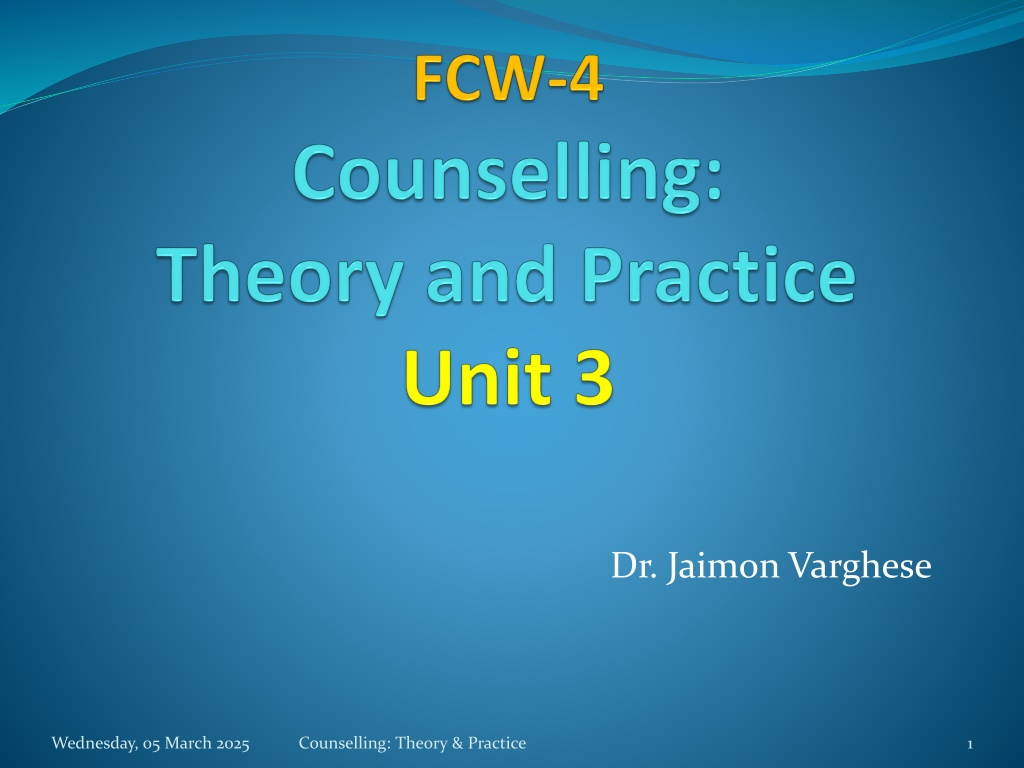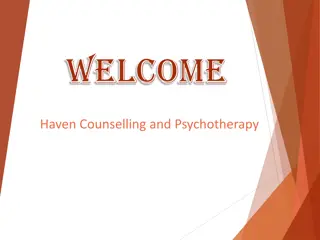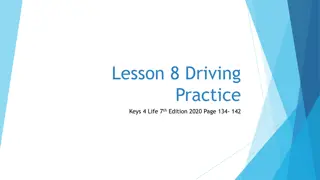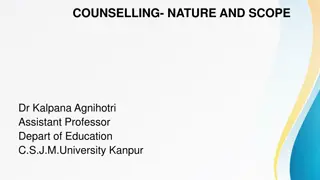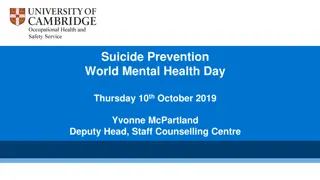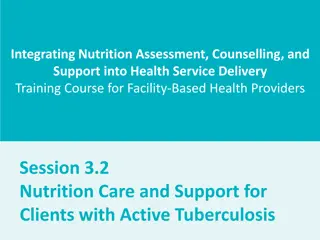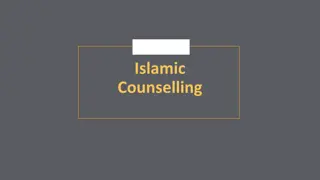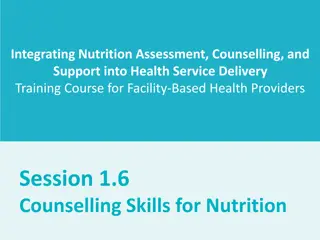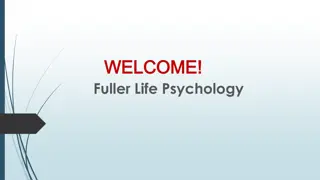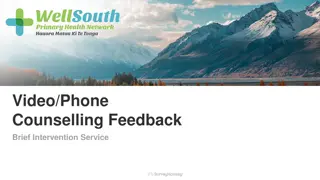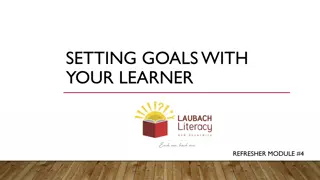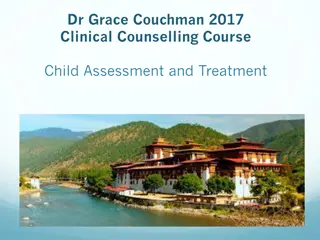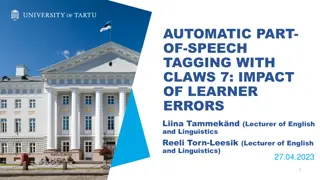Counselling: Theory & Practice - Learner Objectives
Develop holistic understanding of counselling as a tool for help. Acquire knowledge, skills, and attitudes for counselling. Gain insight into different counselling situations and competencies needed for specialized setups. Explore individual, group, couple, family, and telephonic/helpline counselling types. Understand concepts, goals, principles, process, stages, tools, techniques, theories, approaches, competencies, obstacles, stress, burnout, and ethical issues in counselling.
Download Presentation

Please find below an Image/Link to download the presentation.
The content on the website is provided AS IS for your information and personal use only. It may not be sold, licensed, or shared on other websites without obtaining consent from the author.If you encounter any issues during the download, it is possible that the publisher has removed the file from their server.
You are allowed to download the files provided on this website for personal or commercial use, subject to the condition that they are used lawfully. All files are the property of their respective owners.
The content on the website is provided AS IS for your information and personal use only. It may not be sold, licensed, or shared on other websites without obtaining consent from the author.
E N D
Presentation Transcript
Dr. Jaimon Varghese Wednesday, 05 March 2025 Counselling: Theory & Practice 1
Learner Objectives 1. Develop holistic understanding of counselling as a tool for help 2. Acquire knowledge, skills and attitudes for counselling 3. Develop insight in need and areas of counselling in different situations 4. To develop counselling competencies in students for working in various specialized set ups Wednesday, 05 March 2025 Counselling: Theory & Practice 2
Unit 3 Types of Counselling 1. 2. 3. 4. 5. Individual Group Couple Family Telephonic / helpline Counselling Wednesday, 05 March 2025 Counselling: Theory & Practice 3
3.1 Individual Counselling Concept Goals Principles Process Stages Tools Techniques Wednesday, 05 March 2025 Counselling: Theory & Practice 4
Individual Counselling Theories and approaches Counselling Situations & setups Competencies Obstacles Stress and burnout Ethical issues Wednesday, 05 March 2025 Counselling: Theory & Practice 5
3.2 Group Counselling In group counselling a number of individuals work together with a professional counsellor to learn to resolve personal and interpersonal concerns. The primary goal of group counselling is the creation of an interpersonal climate which helps each individual to develop insight into himself It is a process in which free communication among members is encouraged and maintained. leading to an understanding and evaluation of each other's point of view. Wednesday, 05 March 2025 Counselling: Theory & Practice 6
Group Counselling It is a means of helping to resolve problems by enjoying the social process of group dynamics and social facilitation. It is calculated to attain rapid amelioration in personality and behaviour of individual members through specific and controlled group interaction In group counselling individuals explore and analyse their problems together so that they may understand them better, learn to cope with them and learn to make valid choices and decisions. Wednesday, 05 March 2025 Counselling: Theory & Practice 7
Group Counselling The group experience helps them to feel closer to others to find and give emotional support and to understand and accept themselves and others. Feelings of common direction and purpose develop, as group cohesiveness increases. Group counselling has all the three dimensions o f individual counselling viz. remedial, preventive and developmental. Wednesday, 05 March 2025 Counselling: Theory & Practice 8
Group Counselling Assumptions Individuals possess the necessary talent / capacity to trust and to be trusted by other group members providing an atmosphere of support and security for each members each individual has the potential to take responsibility for self change group members can learn and understand from the objectives and methodology of group process to reform the members and not to make them conform. Wednesday, 05 March 2025 Counselling: Theory & Practice 9
Structuring of Groups Selection and induction of members Size of the group (6-10) Composition of the group : homogeneous or heterogeneous with respect to problems, education, intelligence, age, sex and so on. Frequency and duration of meetings: two hour weekly sessions for 11 to 15 weeks Physical setting: privacy and freedom from interruptions; small room rather than large; circular seating arrangement with each member sitting where he pleases Wednesday, 05 March 2025 Counselling: Theory & Practice 10
Process of Group Counselling Initial exploratory stage: counsellor explains his role and the roles of group members. set up facilitative conditions to help develop trust. modelling genuineness, warmth, non- judgemental attitudes to group members and listening carefully Wednesday, 05 March 2025 Counselling: Theory & Practice 11
Process of Group Counselling Transition stage: group members are confronted with the need to explore more deeply to self disclose , letting others know more about oneself, more intensively and to interact more actively with others; resistance to exploring painful feelings Explore more deeply the emotions and feelings that are painful conflict or rebellion resulting from a struggle for power, control or dominance among the members encourage group members to work through conflicts and move toward more authentic self- explorations Wednesday, 05 March 2025 Counselling: Theory & Practice 12
Process of Group Counselling Working stage: feel more close to each other and more aware of others problems sharing feelings and thoughts and to give constructive feedback to each other more supportive and cooperative and hence have more confidence Counsellors challenge each other to convert insights, they have gained in the group into action group becomes productive and committed to going deeply into significant problems and to giving attention to interchanges in the group. Wednesday, 05 March 2025 Counselling: Theory & Practice 13
Process of Group Counselling Working stage: less dependence on the counsellor and the group begins to focus on working towards specified individual goals and group goals. members feel free to confront each other and are more willing to accept confrontations as a constructive means to change. group interactions bring about attitudinal and behavioural changes in the group, members accept challenges among them to reform their everyday life. Wednesday, 05 March 2025 Counselling: Theory & Practice 14
Process of Group Counselling Working stage: Counselling uses a variety of techniques in accordance with their theoretical orientations. Role playing, psycho-drama, assertiveness training, etc. are frequently used techniques Consolidation and Termination fix a termination date in advance start discussion about the termination, three or four sessions before the final one give adequate time for handling psychological or emotional upsets associated with weaning, Wednesday, 05 March 2025 Counselling: Theory & Practice 15
Process of Group Counselling Consolidation and Termination work toward transferring new experiences to outside world, work through any unfinished problems, review the experiences of individual members and work out how each can build on these changes, once the termination is over, Suggestions for future help how to build on new learning by joining a support group or other more advance groups or by reading or by attending workshops, etc. Wednesday, 05 March 2025 Counselling: Theory & Practice 16
Advantages of Group Counselling It is economical, saves time and money. helps individuals to socialize their attitudes, habits and judgments. provides multiple stimuli for each member to work through and approximates real life situation. By frank and honest sharing of thoughts and feelings members develop a feeling of group cohesiveness and singleness of purpose that helps them to progress. Wednesday, 05 March 2025 Counselling: Theory & Practice 17
Advantages of Group Counselling Discussion of matters of common concern help the members to appraise the adequacy of their interpersonal relations. The group gives a practice field to learn new more flexible and more satisfying ways of relating to others. the group helps the individual appraise his values and come to an increased appreciation of the importance of good human relations in his value system Wednesday, 05 March 2025 Counselling: Theory & Practice 18
Advantages of Group Counselling Some individuals who cannot be reached through individual counselling can be reached through group counselling. In a group counselling situation feelings of depression, isolation are reduced and talking made easy. In a group counselling situation feelings of depression, isolation are reduced and talking made easy. group counselling gives the counsellor an opportunity to study persons in an initial group setting. Wednesday, 05 March 2025 Counselling: Theory & Practice 19
Limitations of Group Counselling Group counselling is not suitable for some individual who find the group situation too threatening. some individuals have a very low level of tolerance and will not be able to adopt their behaviour to the demands of the group. Very personal and private problems cannot be discussed in the group situation. Wednesday, 05 March 2025 Counselling: Theory & Practice 20
Limitations of Group Counselling counsellor has less control over the situation in group counselling; the counsellor may sometimes find himself seriously impeded in establishing good working relationship with members. The counsellor has to take into consideration several factors and decide whether group counselling is suitable for particular individuals and type of problem. Wednesday, 05 March 2025 Counselling: Theory & Practice 21
3.4 Family Counselling Family Therapy is a branch of psychotherapy that works with families and couples in intimate relationships to nurture change and development Important areas, namely, pre-marital counselling, counselling for better marital harmony counselling to eliminate or forestall a marriage from breaking up (divorce-4.1) Wednesday, 05 March 2025 Counselling: Theory & Practice 22
Family Counselling Important areas, namely, Couple counselling (3.3) marital / live- in disputes (4.1) domestic violence (4.1) planned parenthood &parenting (4.3) MTP (4.3) Infertility (4.3) Adoption (4.3) Wednesday, 05 March 2025 Counselling: Theory & Practice 23
Family Counselling In marriage counselling the client is not either of the married partners but the marriage relationship itself a form of crises intervention Emerging issues sharp rise in the divorce rate (50 to 65%) the changing role of women. The expansion of the life span; not sure how to relate to the family members over time, as there were few previous models Wednesday, 05 March 2025 Counselling: Theory & Practice 24
Family Counselling Basic premises psychologically healthy counsellors: not contaminate sessions with unresolved personal /family issues Balance: not to overemphasizes or under emphasize possible aspects or interventions Structure (contract): how often & for how long; Initiative from couples; once counselor listen and outline what they see as possibilities, couple or family members often pull together common goals Wednesday, 05 March 2025 Counselling: Theory & Practice 25
Family Counselling Basic premises psychologically healthy counsellors: not contaminate sessions with unresolved personal /family issues Structure (contract): how often & for how long; Initiative from couples; once counselor listen and outline what they see as possibilities, couple or family members often pull together common goals Wednesday, 05 March 2025 Counselling: Theory & Practice 26
Family Counselling Basic premises understanding of how couples and families became either more together or apart when faced with different life stages, cultural norms, or situational circumstances Balance: not to overemphasizes or under emphasize possible aspects or interventions Wednesday, 05 March 2025 Counselling: Theory & Practice 27
Family Counselling - Steps 1. Intake: 2. Assessment: 3. Diagnosis based on structure & functions. 4. Hypothesis formulation; intervention plan 5. Intervention: counselling using circular question 6. Termination and follow ups Wednesday, 05 March 2025 Counselling: Theory & Practice 28
1. Understanding family (Intake) Family is a small social system made up of individuals related to each other by reason of strong reciprocal affection and loyalties compromising permanent household or cluster of households. Member enters through birth, adoption or marriage, and leave only by death. Wednesday, 05 March 2025 Counselling: Theory & Practice 29
Understanding family (Intake) understand the family s perception of their problem, their motivation and need to undergo family intervention and the therapist s assessment of suitability for family therapy Family life cycle: the natural history of Family formation, Expansion, Contraction, and Dissolution. there is rearrangement of role reciprocities over the growing life cycle Wednesday, 05 March 2025 Counselling: Theory & Practice 30
Understanding family life cycle Stages I: Married couples without children Stage II: Child bearing Families ( I Child 0-30 months) Stage III: Family with pre-school children (30 mths-6 yrs) Stage IV: Family with school age children (6 yrs- 13yrs) Wednesday, 05 March 2025 Counselling: Theory & Practice 31
Understanding family life cycle Stage V: Family with teenagers (13 yrs 20 yrs) Stage VI: Family with Launching young adults Stage VII: Family with middle age parents (Empty nest to retirement) Stage VIII: Ageing family (Retirement to Death of one Spouse) Wednesday, 05 March 2025 Counselling: Theory & Practice 32
2. The Family Assessment 3-5 sessions with the whole family lasting approximately 45 minutes each start with a three generation genogram (family tree) and follow up with the different life cycle stages and family functions Trans-generational family patterns and interactions are looked at Wednesday, 05 March 2025 Counselling: Theory & Practice 33
The Family Assessment The life cycle & functions of the index family is explored next see how the family has coped with problems and the process of transition from one stage to another Wednesday, 05 March 2025 Counselling: Theory & Practice 34
Approaches to study a Family Institutional approach, Interactional approach, Structural functional approach, Situational approach, Learning approach, Home management approach, Family development approach Wednesday, 05 March 2025 Counselling: Theory & Practice 35
3. Diagnosis: Family structure Composition - Three Generation Genogram Boundaries - the rules defining who participate in the system and how i.e, the degree of access outsiders have to the system. Boundaries can be clear/open, diffuse, closed and rigid. Subsystem is one element of the total system in a state of dynamic interchange with contiguous subsystems Wednesday, 05 March 2025 Counselling: Theory & Practice 36
3. Diagnosis: Family structure Alignments - consist of coalitions, alliances, triangulation and detouring Coalition - when alignments stand in opposition to another part of the system Alliance is the joining together of two or more members, potentially neutral having an inherent capacity to become aggressive directed to a third party Wednesday, 05 March 2025 Counselling: Theory & Practice 37
3. Diagnosis: Family structure Triangulation is a situation where two parents (unit) in overt/covert conflict attempt to enlist the child s (a third unit s) sympathy or support against the other Conflict detouring refers to arrangements of two against one Wednesday, 05 March 2025 Counselling: Theory & Practice 38
3. Diagnosis: Family structure Detouring attacking means bonding together to scapegoat the third Detouring-supportive is one parent mask the differences by focusing on a child who is defined as sick . Decision Making Process: Authoritarian or Democratic Wednesday, 05 March 2025 Counselling: Theory & Practice 39
3. Diagnosis: Family structure Role structure and functioning Multiplicity and complementarities of roles Role expectation and performance Role allocation and role conflict / strain Diffusion and ambiguity Explicit and implicit Role acceptance / accountability Instrumental and expressive roles (mediator) Wednesday, 05 March 2025 Counselling: Theory & Practice 40
3. Diagnosis: Family structure Communication a) channels/noise level /equality of participation/clarity of communication b) direct-indirect; verbal-nonverbal c) ambiguous/paradoxical/switchboard Affective status communication of feelings three elements of the process - perception, evaluation and transmission Wednesday, 05 March 2025 Counselling: Theory & Practice 41
3. Diagnosis: Family structure Reinforcement Processes adopted by the family members to imbibe socially approved behaviour Positive & Negative reinforcement Cohesiveness commitment and the degree of intimacy in the interpersonal dimension Enmeshed - healthy connectedness - healthy separateness disengaged. Wednesday, 05 March 2025 Counselling: Theory & Practice 42
3. Diagnosis: Family structure Healthy individuals are both separate (Well differentiated) & connected (intimate) parameters of Cohesiveness social, personal and emotional activities we feeling, bonds, dependence, independence family rituals: symbolic form of communication stabilizes family life by clarifying expected roles Wednesday, 05 March 2025 Counselling: Theory & Practice 43
3. Diagnosis: Family structure Adaptive Patterns Coping strategy refers to an action, series of actions or thought process utilized in meeting a stressful or unpleasant situation or modifying one s reaction to such a situation. a conscious and direct approach to problems in contrast to defense mechanisms Wednesday, 05 March 2025 Counselling: Theory & Practice 44
3. Diagnosis: Family structure Adaptive Patterns problem solving ability refers to the process of developing a new response to situation for which no existing behavioural pattern is available to achieve a goal Steps of problem solving Define the problem Identify different alternatives Find out +ves and ves of each alternative Choose the best- more +ves & less ves Implement it Wednesday, 05 March 2025 Counselling: Theory & Practice 45
3. Diagnosis: Family structure Social support systems the formal and informal relationships and groups through which an individual receives moral cognitive and supports necessary to master stressful experience Level of support Primary: Support from immediate family Secondary: include relatives, friends & neighbors Tertiary: Hospital, voluntary & Govt. agencies and religious institutions Wednesday, 05 March 2025 Counselling: Theory & Practice 46
4. Counselling Intervention Schools of family counselling Psychodynamic therapy understands the dynamics employed by different members of the family and the interrelationships ego defenses and Family transferences are interpreted goal of therapy is to effect emotional insight and working through new defense patterns Wednesday, 05 March 2025 Counselling: Theory & Practice 47
4. Counselling Intervention Schools of family counselling Psychodynamic therapy Employed in persons who are psychologically sophisticated and able to understand dynamics and interpretations 15 -30 sessions; Sustained and high motivation is necessary Wednesday, 05 March 2025 Counselling: Theory & Practice 48
4. Counselling Intervention Schools of family counselling Behavioural methods psycho-education and skills training in communication and problem solving Structural family therapy The family boundaries are identified and if they are dysfunctional they are realigned. Wednesday, 05 March 2025 Counselling: Theory & Practice 49
4. Counselling Intervention Circular questions Ask who agrees with whom each member s explanation for certain member s behaviour Ask questions to each member about the other family members; their behaviors, beliefs, values, thoughts, traditions, habits, feelings and relationships Attempt to discover the full cycle or sequence of inter-member behaviors, thereby perpetuating it Wednesday, 05 March 2025 Counselling: Theory & Practice 50
